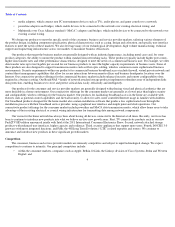Netgear 2011 Annual Report Download - page 18
Download and view the complete annual report
Please find page 18 of the 2011 Netgear annual report below. You can navigate through the pages in the report by either clicking on the pages listed below, or by using the keyword search tool below to find specific information within the annual report.
Table of Contents
we can. We anticipate that current and potential competitors will also intensify their efforts to penetrate our target markets. For example, price
competition is intense in our industry in certain geographical regions and product categories. Specifically in the service provider space, many of
our competitors price their products significantly below our product costs in order to gain market share. Average sales prices have declined in the
past and may again decline in the future. These competitors may have more advanced technology, more extensive distribution channels, stronger
brand names, greater access to shelf space in retail locations, bigger promotional budgets and larger customer bases than we do. These
companies could devote more capital resources to develop, manufacture and market competing products than we could. If any of these
companies are successful in competing against us, our sales could decline, our margins could be negatively impacted and we could lose market
share, any of which could seriously harm our business and results of operations.
Economic conditions are likely to materially adversely affect our revenue and results of operations.
Our business has been and may continue to be affected by a number of factors that are beyond our control such as general geopolitical,
economic and business conditions, conditions in the financial services markets, and changes in the overall demand for networking products. A
severe and/or prolonged economic downturn could adversely affect our customers’ financial condition and the levels of business activity of our
customers. Continued uncertainty about current global economic conditions could cause businesses to postpone spending in response to tighter
credit, negative financial news and/or declines in income or asset values, which could have a material negative effect on the demand for
networking products.
The recent economic problems affecting the banking system and financial markets and the recent uncertainty in global economic
conditions has resulted in a number of adverse effects including tightening in the credit markets, a low level of liquidity in many financial
markets, extreme volatility in credit, equity, currency and fixed income markets, instability in the stock market and high unemployment. For
example, the recent challenges faced by the European Union to stabilize some of its member economies, such as Greece, Portugal, Spain,
Hungary and even Italy, has had international implications affecting the stability of global financial markets and hindering economies
worldwide. Should the European Union monetary policy measures be insufficient to restore confidence and stability to the financial markets, the
recovery of the global economy, including the U.S. and European Union economies where we have a significant presence, could be hindered or
reversed, which could have a material adverse effect on us. There could also be a number of follow-on effects from these economic
developments and negative economic trends on our business, including the inability of customers to obtain credit to finance purchases of our
products; customer insolvencies; decreased customer confidence to make purchasing decisions; decreased customer demand; and decreased
customer ability to pay their trade obligations.
If conditions in the global economy, including Europe and the U.S., or other key vertical or geographic markets remain uncertain or
weaken further, such conditions could have a material adverse impact on our business, operating results and financial condition. In addition, if
we are unable to successfully anticipate changing economic and political conditions, we may be unable to effectively plan for and respond to
those changes, which could materially adversely affect our business and results of operations.
Our business is subject to the risks of international operations.
We derive a significant portion of our revenue from international operations. As a result, our financial condition and operating results
could be significantly affected by risks associated with international activities, including economic and labor conditions, political instability, tax
laws, changes in the value of the U.S. dollar versus local currencies, and natural disasters. Margins on sales of our products in foreign countries,
and on sales of products that include components obtained from foreign suppliers, could be materially adversely affected by foreign currency
exchange rate fluctuations and by international trade regulations. Additionally, certain foreign countries have complex regulatory requirements
as conditions of doing business. For example, the United Kingdom Anti-Bribery Act of 2010 is broad legislation that prohibits bribery and
applies to our operations
14
























